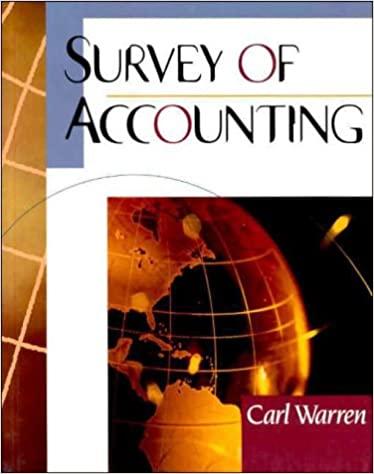Question
3. Partnership losses that are not used because a partner's basis in the partnership interest is zero may not be carried forward and are lost
3. Partnership losses that are not used because a partner's basis in the partnership interest is zero may not be carried forward and are lost by the partner.
a. True
b. False
7. A partner's receipt of guaranteed payments is a form of qualified business income.
a. True
b. False
11. Which of the following is true with respect to capital gains and losses of a corporation?
a. A corporation can offset ordinary income with capital losses.
b. A corporation pays 15 percent long-term capital gains rate, just like an individual.
c. A corporation can carry a capital loss back 5 years.
d. A corporation can carry a capital loss forward 5 years.
18. At which of the following IRS locations are tax returns processed?
a. Regional offices
b. IRS Campus Processing Sites
c. Local offices
d. National office
e. None of these
19. In the following independent situations, is it better to make an installment agreement with the IRS, an offer in compromise with the IRS, or ask for an extension of time to pay any taxes owed?
a. A taxpayer is unlikely to pay the tax amount they owe.
b. Using monthly payments, a taxpayer can afford to pay off the tax owed within 2 years.
c. A taxpayer can pay off their tax owed when they sell their boat which is up for sale.
23. An "office audit" is an audit in which the revenue agent visits the taxpayer's office.
a. True
b. False
28. A "correspondence audit" by the IRS is conducted through the mail.
a. True
b. False
29. List three different ways that a tax return may be selected for an audit.
30. As a result of an IRS audit, a taxpayer may be required to pay additional taxes, but he or she is never paid a refund.
a. True
b. False
33. If a taxpayer has too much income tax withheld from his salary during the tax year, the IRS will pay interest on the excess amount.
a. True
b. False
34. Interest paid on an underpayment of taxes (other than an underpayment of estimated taxes) is not subject to the consumer interest limitation.
a. True
b. False
36. Linda filed her individual income tax return on its due date but failed to pay $1,000 in taxes that were due with the return. Linda promptly paid the taxes upon receipt of a notice and demand for payment. If Linda pays the taxes exactly 5 months late, calculate the amount of her failure-to-pay penalty.
38. The statute of limitations for a tax return generally is 3 years.
a. True
b. False
39. What are the requirements that an unenrolled preparer needs to do in order to participate in the Annual Filing Season Program?
Indicate the answer choice that best completes the statement or answers the question.
41. All paid tax return preparers must sign up with the IRS and obtain a preparer tax identification number.
a. True
b. False
47. Mark with a "Yes" if the following statement is true and is in Publication 1, The Taxpayers Bill of Rights. Mark with
a "No" if the following statement is false or is not addressed in Publication 1.
a. If you do not agree with the IRS examiner's proposed changes in an audit, you must go directly to the court system to resolve the issue.
b. If a taxpayer is due a refund, but did not file a return, then the IRS uses statistics to reconstruct an individual's income in order to compute the refund for the taxpayer.
c. The tax law generally provides for interest on your refund if it is not paid within 45 days of the date you filed your return or filed your claim for refund.
d. Publication 1 explains how to file an amended tax return.
Indicate whether the statement is true or false.
48. A taxpayer with an average tax rate of 20 percent who receives additional income of $20,000 will pay additional taxes of $4,000.
a. True
b. False
Indicate the answer choice that best completes the statement or answers the question.
49. Which of the following taxpayers will benefit most in terms of dollars saved as a result of tax planning to reduce taxes?
a. An individual taxpayer who has a marginal tax rate of 32 percent.
b. An individual taxpayer who has an average tax rate of 32 percent.
c. An individual taxpayer who has a marginal tax rate of 24 percent.
d. The taxpayers in a and b will benefit equally.
e. None of these.
Indicate whether the statement is true or false.
50. Tax evasion involves the use of illegal methods to reduce or avoid income tax.
a. True
b. False
Step by Step Solution
There are 3 Steps involved in it
Step: 1

Get Instant Access to Expert-Tailored Solutions
See step-by-step solutions with expert insights and AI powered tools for academic success
Step: 2

Step: 3

Ace Your Homework with AI
Get the answers you need in no time with our AI-driven, step-by-step assistance
Get Started


